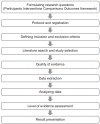Introduction to systematic review and meta-analysis
- PMID: 29619782
- PMCID: PMC5903119
- DOI: 10.4097/kjae.2018.71.2.103
Introduction to systematic review and meta-analysis
Abstract
Systematic reviews and meta-analyses present results by combining and analyzing data from different studies conducted on similar research topics. In recent years, systematic reviews and meta-analyses have been actively performed in various fields including anesthesiology. These research methods are powerful tools that can overcome the difficulties in performing large-scale randomized controlled trials. However, the inclusion of studies with any biases or improperly assessed quality of evidence in systematic reviews and meta-analyses could yield misleading results. Therefore, various guidelines have been suggested for conducting systematic reviews and meta-analyses to help standardize them and improve their quality. Nonetheless, accepting the conclusions of many studies without understanding the meta-analysis can be dangerous. Therefore, this article provides an easy introduction to clinicians on performing and understanding meta-analyses.
Keywords: Anesthesiology; Meta-analysis; Randomized controlled trial; Systematic review.
Figures






Similar articles
-
Evidence-based medicine, systematic reviews, and guidelines in interventional pain management: part 6. Systematic reviews and meta-analyses of observational studies.Pain Physician. 2009 Sep-Oct;12(5):819-50. Pain Physician. 2009. PMID: 19787009
-
Publication Bias and Nonreporting Found in Majority of Systematic Reviews and Meta-analyses in Anesthesiology Journals.Anesth Analg. 2016 Oct;123(4):1018-25. doi: 10.1213/ANE.0000000000001452. Anesth Analg. 2016. PMID: 27537925 Review.
-
Systematic reviews and meta-analyses of randomized trials: principles and pitfalls.Eur Heart J. 2014 Dec 14;35(47):3336-45. doi: 10.1093/eurheartj/ehu424. Eur Heart J. 2014. PMID: 25416325
-
Systematic reviews and meta-analyses: an illustrated, step-by-step guide.Natl Med J India. 2004 Mar-Apr;17(2):86-95. Natl Med J India. 2004. PMID: 15141602
-
Systematic reviews and their application to research in speech and language therapy: a response to T. R. Pring's 'Ask a silly question: two decades of troublesome trials' (2004).Int J Lang Commun Disord. 2006 Jan-Feb;41(1):95-105. doi: 10.1080/13682820500071542. Int J Lang Commun Disord. 2006. PMID: 16272005 Review.
Cited by
-
Healing of Humerus Non-union Fracture Using Recombinant Human Bone Morphogenetic Protein With Bone Graft Compared to Bone Graft Alone: A Systematic Review and Meta-Analysis.Cureus. 2024 Oct 17;16(10):e71732. doi: 10.7759/cureus.71732. eCollection 2024 Oct. Cureus. 2024. PMID: 39429996 Free PMC article. Review.
-
Parental Reminder Strategies and the Cost Implication for Improved Immunisation Outcomes: A Systematic Review and Meta-Analysis.Healthcare (Basel). 2022 Oct 11;10(10):1996. doi: 10.3390/healthcare10101996. Healthcare (Basel). 2022. PMID: 36292443 Free PMC article. Review.
-
Comparative Analysis of Sedative Efficacy of Dexmedetomidine and Midazolam in Pediatric Dental Practice: A Systematic Review and Meta-Analysis.Cureus. 2022 Aug 26;14(8):e28452. doi: 10.7759/cureus.28452. eCollection 2022 Aug. Cureus. 2022. PMID: 36176880 Free PMC article. Review.
-
Coping With the Experiences of Intimate Partner Violence Among South African Women: Systematic Review and Meta-Synthesis.Front Psychiatry. 2021 May 26;12:655130. doi: 10.3389/fpsyt.2021.655130. eCollection 2021. Front Psychiatry. 2021. PMID: 34122178 Free PMC article.
-
Modeling COVID-19 Transmission Dynamics: A Bibliometric Review.Int J Environ Res Public Health. 2022 Oct 29;19(21):14143. doi: 10.3390/ijerph192114143. Int J Environ Res Public Health. 2022. PMID: 36361019 Free PMC article. Review.
References
-
- Kang H. Statistical considerations in meta-analysis. Hanyang Med Rev. 2015;35:23–32.
-
- Uetani K, Nakayama T, Ikai H, Yonemoto N, Moher D. Quality of reports on randomized controlled trials conducted in Japan: evaluation of adherence to the CONSORT statement. Intern Med. 2009;48:307–13. - PubMed
-
- Moher D, Cook DJ, Eastwood S, Olkin I, Rennie D, Stroup DF. Improving the quality of reports of meta-analyses of randomised controlled trials: the QUOROM statement. Quality of Reporting of Meta-analyses. Lancet. 1999;354:1896–900. - PubMed
-
- Liberati A, Altman DG, Tetzlaff J, Mulrow C, Gøtzsche PC, Ioannidis JP, et al. The PRISMA statement for reporting systematic reviews and meta-analyses of studies that evaluate health care interventions: explanation and elaboration. J Clin Epidemiol. 2009;62:e1–34. - PubMed
LinkOut - more resources
Full Text Sources
Other Literature Sources

